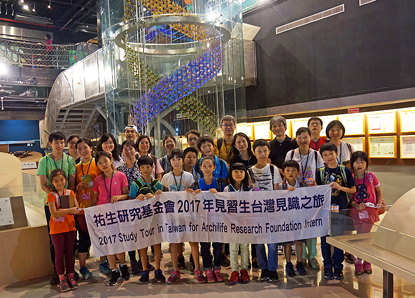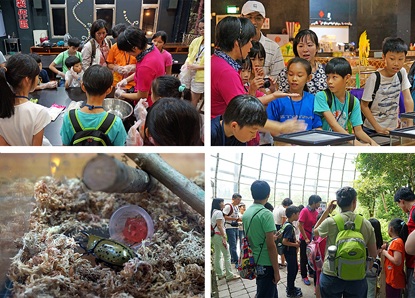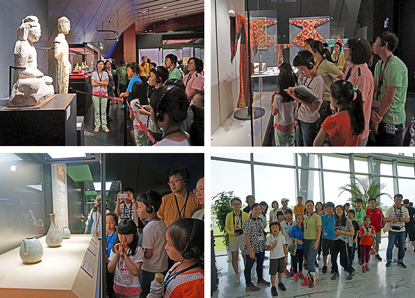Sketch of Archilife Study Tour, July 2017
|
2017年7月份見識之旅縮影  7月份見識之旅活動,於2017年7月15日由呂明澐小姐帶領26位祐生見習生及家長們,進行嘉大昆蟲生態教育暨亞洲藝術文化之旅。活動開始之初,領隊呂明澐小姐提醒本次活動注意事項及觀察重點,先行建立見習生的背景知識。 7月份見識之旅活動,於2017年7月15日由呂明澐小姐帶領26位祐生見習生及家長們,進行嘉大昆蟲生態教育暨亞洲藝術文化之旅。活動開始之初,領隊呂明澐小姐提醒本次活動注意事項及觀察重點,先行建立見習生的背景知識。For the study tour of July 15, 2017, Ms. Lu Ming-yun led 26 ARF interns and their parents on a discovery tour to Chiayi to learn about insect ecology and Asian art and culture. At the start of the day's activities, team leader Ms. Lu Ming-yun reminded everyone about things to note and what to observe, and provided the interns some general background knowledge.  本次上午行程參訪嘉大昆蟲館,嘉大昆蟲館以生態教育為主軸,期望透過親自接觸與體驗,進一步體認生命與愛護自然的重要性。行程首先進行手洗愛玉DIY活動,導覽人員一開始即介紹愛玉的由來,並配合教學小卡解說愛玉的食療功效,之後說明洗愛玉的步驟及要訣,教導如何分辨市面上販售的愛玉是真或假。隨後,至一旁昆蟲體驗區進行導覽,導覽人員自飼養箱中取出昆蟲,讓眾人近距離觀察與觸摸,並講解其特徵及習性,有別於一般昆蟲館僅供展示標本的做法,使見習生能以互動的方式學習更多相關知識。最後來到溫室蝴蝶花園區,溫室內以台灣中低海拔原始林相與水源為造景,說明植物、水源與蝴蝶生態的相關性,不僅能與蝴蝶互動,亦可發現其完全變態前的蛹狀及毛毛蟲的形貌,見習生得以親眼見到蝴蝶蛻變前後的態樣。 本次上午行程參訪嘉大昆蟲館,嘉大昆蟲館以生態教育為主軸,期望透過親自接觸與體驗,進一步體認生命與愛護自然的重要性。行程首先進行手洗愛玉DIY活動,導覽人員一開始即介紹愛玉的由來,並配合教學小卡解說愛玉的食療功效,之後說明洗愛玉的步驟及要訣,教導如何分辨市面上販售的愛玉是真或假。隨後,至一旁昆蟲體驗區進行導覽,導覽人員自飼養箱中取出昆蟲,讓眾人近距離觀察與觸摸,並講解其特徵及習性,有別於一般昆蟲館僅供展示標本的做法,使見習生能以互動的方式學習更多相關知識。最後來到溫室蝴蝶花園區,溫室內以台灣中低海拔原始林相與水源為造景,說明植物、水源與蝴蝶生態的相關性,不僅能與蝴蝶互動,亦可發現其完全變態前的蛹狀及毛毛蟲的形貌,見習生得以親眼見到蝴蝶蛻變前後的態樣。The morning's itinerary began with a visit to NCYU Insect Museum. Focusing on ecological education, the museum provides a place for visitors to get up close and personal with insects, allowing them to understand the importance of life and nature conservation. The tour began with DIY aiyu jelly washing. The tour guide firstly introduced the origin of aiyu jelly and explained its dietary benefits using educational flash cards. This was then followed by explanation of the steps and tips for washing aiyu jelly, and instruction on differentiating real and fake aiyu jelly sold in the market. The next part of the tour was to the insect terrarium area of the museum. The tour guide removed insects from the terrarium to allow everyone to observe and touch them, and explained their characteristics and habits. Unlike ordinary insect museums where only specimens are put on display, the NCYU Insect Museum allows interns to gain more knowledge through interactive learning. The tour ended with a visit to the butterfly garden greenhouse, which is modeled after Taiwan's low-and mid-altitude primeval forests and water sources. The tour guide explained the connection between plants, water sources and butterfly ecology. Interns not only could interact with butterflies, they also witnessed what the butterfly looked like before and after metamorphosis.  中午飯後,乘車前往位於嘉義縣太保市的故宮南院,其定位為「亞洲藝術文化博物館」,期盼與台北故宮達到「平衡南北、文化均富」的理念。一開始即以嘉義發展史為題,主要透過古籍、地圖及清代文獻檔案,刻畫早期嘉義地區政經制度、原住民文化與風土環境等,讓人能以不同面向了解早期嘉義的發展歷程。隨後前往佛教藝術展館,館內藉由佛像雕刻及經典流布,闡述亞洲佛教藝術多元化的成就,以及亞洲深厚的人文底蘊;再者為亞洲織品區,亞洲多樣的織品系統,反映幅員遼闊且自然地理樣貌多變的環境;接著亦介紹中國茶文化的淵源發展,以及高麗青瓷釉彩之美與南亞玉器之精工。經過一連串代表亞洲文明鼎盛時期的藝術成就巡禮,見習生皆對於這些亞洲歷史見證有初步的印象。至此,本日活動已近尾聲,大家一起合照留念後各自返家,並期待於下次見識之旅再相見。 中午飯後,乘車前往位於嘉義縣太保市的故宮南院,其定位為「亞洲藝術文化博物館」,期盼與台北故宮達到「平衡南北、文化均富」的理念。一開始即以嘉義發展史為題,主要透過古籍、地圖及清代文獻檔案,刻畫早期嘉義地區政經制度、原住民文化與風土環境等,讓人能以不同面向了解早期嘉義的發展歷程。隨後前往佛教藝術展館,館內藉由佛像雕刻及經典流布,闡述亞洲佛教藝術多元化的成就,以及亞洲深厚的人文底蘊;再者為亞洲織品區,亞洲多樣的織品系統,反映幅員遼闊且自然地理樣貌多變的環境;接著亦介紹中國茶文化的淵源發展,以及高麗青瓷釉彩之美與南亞玉器之精工。經過一連串代表亞洲文明鼎盛時期的藝術成就巡禮,見習生皆對於這些亞洲歷史見證有初步的印象。至此,本日活動已近尾聲,大家一起合照留念後各自返家,並期待於下次見識之旅再相見。After lunch, everyone took a ride to the Southern Branch of the National Palace Museum in Taibao City, Chiayi County. Set as an "Asian Art and Culture Museum", the Southern Branch Museum seeks to achieve culture equity between the Northern and the Southern regions of Taiwan. The tour began with a focus on the developmental history of Chiayi. The museum presents the economic and political systems in the early days of Chiayi, and its indigenous culture and native environment, through ancient books, maps and Qing Dynasty written records, allowing visitors to learn about the development of early Chiayi from various perspectives. Next, everyone visited the Buddhist art exhibition, where Buddhist sculptures and sutras portray the diversity of Asian Buddhist art and its cultural depth. In the Asian textiles exhibition area, the myriad variety of textile systems in Asia reflects its geographical vastness and diversity. Everyone also learned about the origin of Chinese tea, the beauty of Korean celadon and exquisite craftsmanship of South Asian jade. The interns gained a preliminary impression of Asian history after viewing these artistic accomplishments from the peak of Asian civilization. At this point, the day's itinerary came to an end. Everyone returned to home after taking a group photo and looked forward to the next study tour. |

